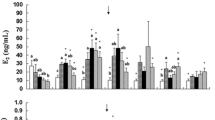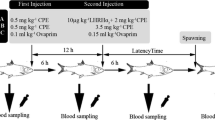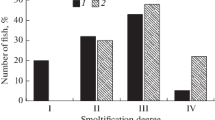Abstract
Mummichogs (Fundulus heteroclitus) were exposed to various regimens of temperature and photoperiod in order to develop a routine husbandry procedure so as to have throughout the year a population of reproductively healthy fish with a good quantity and quality of prematuration follicles (1.2–1.5 mm) suitable for carrying out homologous bioassays ofF. heteroclitus gonadotropin. During the fall and winter months, wild fish in the field all had regressed ovaries (gonadosomatic index <1). On the other hand, laboratory-maintained fish, with or without cold temperature (15°C) and short photoperiod (10 h light/day) pretreatment, generally had sexually mature ovaries (GSI>10) when maintained on a warm temperature (25°C) and long photoperiod (14 h light) protocol. Ovarian follicles retrieved from laboratory fish were responsive toF. heteroclitus pituitary extract stimulation, and underwent germinal vesicle breakdown normallyin vitro. Hence these ovarian follicles served well as a bioassay forF. heteroclitus gonadotropin even outside of the normal breeding season. The pituitary glands retrieved from laboratory fish in winter also retained high gonadotropic potencies, in terms of maturational and steroidogenic activities. Our results thus demonstrated that active gametogenesis in laboratory-maintained fish can be extended five months beyond the end of the normal breeding season. Apparently,F. heteroclitus in Florida is potentially a continuous breeder when under favorable conditions, but has a reproductive quiescent period imposed upon it by some environmental stressor(s). Although the design of the present experiments did not determine the relative importance of nutritional factors, temperature, and photoperiod on the annual reproductive cycle ofF. heteroclitus, there are indications that diatary factors may play a much more dominant role in the reproductive cycle than previously recognized.
Similar content being viewed by others
References cited
Boyd, J.F. and Simmonds, R.C. 1974. Continuous laboratory production of fertileFundulus heteroclitus (Walbaum) eggs lacking chorionic fibrils. J. Fish Biol. 6: 389–394.
Bradford, C.S. and Taylor, M.H. 1987. Semilunar changes in estradiol and cortisol coincident with gonadal maturation and spawning in the killifishFundulus heteroclitus. Gen. Comp. Endocrinol. 66: 71–78.
Bromage, N.R., Elliott, J.A.K., Springate, J.R.C. and Whitehead, C. 1984. The effects of constant photoperiods on the timing of spawning in the rainbow trout. Aquaculture 43: 213–223.
Burger, J.W. 1939. Some experiments on the relation of the external environment to the spermatogenetic cycle ofFundulus heteroclitus (L.). Biol. Bull. 77: 96–103.
Burger, J.W. 1940. Some further experiments on the relation of the external environment to the spermatogenetic cycle ofFundulus heteroclitus. Bull Mt. Desert Island Biol. Lab. 42nd Season: 20–21.
Day, J.R. and Taylor, M.H. 1983. Environmental control of the annual gonadal cycle ofFundulus heteroclitus L: The pineal organ and eyes. J. Exp. Zool. 227: 453–458.
Day, J.R. and Taylor, M.H. 1984. Photoperiod and temperature interaction in the seasonal reproduction of female mummichogs. Trans. Am. Fish. Soc. 113: 452–457.
deVlaming, V.L. 1972a Environmental control of teleost reproductive cycles: a brief review. J. Fish Biol. 4: 131–140.
deVlaming, V.L. 1972b. The effects of temperature and photoperiod on reproductive cycling in the estuarine gobiid fishGillichthys mirabilis. Fish. Bull. 70: 1137–1152.
deVlaming V.L. 1975. Effects of photoperiod and temperature on gonadal activity in the cyprinid teleost,Notemigonus crysoleucas. Biol. Bull. 148: 402–415.
Fivizzani, A.J. and Porter, D.A. 1984. Seasonal variation in the effect of thermal stimulation on reproduction in two species ofFundulus.In Chronobiology 1982–1983. 15th International Conference of the International Society for Chronobiology. pp. 43–48. Edited by E. Haus and H.F. Kabat, S. Karger Publishers, Inc. Basel.
Fries, C.R. 1986. Effects of environmental stressors and immunosuppressants on immunity inFundulus heteroclitus. Am. Zool. 26: 271–282.
Gillet, C., Breton, B. and Billard, R. 1978. Seasonal effects of exposure to temperature and photoperiod regimes on gonad growth and plasma gonadotropin in goldfish (Carassius auratus). Ann. Biol. Anim. Bioch. Biophys. 18: 1045–1049.
Greeley, M.S., Jr., Calder, D.R., Taylor, M.H., Hols, H. and Wallace, R.A. 1986. Oocyte maturation in the mummichog (Fundulus heteroclitus): Effects of steroids on germinal vesicle breakdown of intact folliclesin vitro. Gen. Comp. Endocrinol. 62: 281–289.
Greeley, M.S., Jr., Calder, D.R. and Wallace, R.A. 1987. Oocyte growth and development in the stripped mullet,Mugil cephalus, during seasonal ovarian recrudescence: relationship to fecundity and size at maturity. Fish. Bull. 85: 187–200.
Kaya, C.M. 1973. Effects of temperature and photoperiod on seasonal regression of gonads of green sunfish,Leopomis cyanellus. Copeia 1973: 369–373.
Kaya, C.M. and Hasler, A.D. 1972. Photoperiod and temperature effects on the gonads of green sunfish,Lepomis cyanellus (Rafinesque), during the quiescent, winter phase of its annual sexual cycle. Trans. Am. Fish. Soc. 101: 270–275.
Lin, Y-W.P. and Schuetz, A.W. 1985. Intrafollicular action of estrogen in regulating pituitary-induced ovarian progesterone synthesis and oocyte maturation inRana pipiens: Temporal relationship and locus of action. Gen. Comp. Endocrinol. 58: 421–435.
Lin, Y-W.P., LaMarca, M.J. and Wallace, R.A. 1987.Fundulus heteroclitus gonadotropin(s) 1. Homologous bioassay using oocyte maturation and steroid production by isolated ovarian follicles. Gen. Comp. Endocrinol. 67: 126–141.
Miller, N.W. and Tripp, M.R. 1982a. The effect of captivity on the immune response of the killifish,Fundulus heteroclitus L. J. Fish Biol. 20: 301–308.
Miller, N.W. and Tripp, M.R. 1982b. An immunoinhibitory substance in the serum of laboratory held killifish,Fundulus heteroclitus. L. J. Fish Biol. 20: 309–316.
Redway, J.D. and Redway, A.S. 1980. Induced production of fertileFundulus heteroclitus eggs in small laboratory aquarium systems. Bios. 51: 215–224.
Slicher, A.M., Pickford, G.E. and Pang, P.K.T. 1966. Effects of “training” and of volume and composition of the injection fluid on stress-induced leukopenia in the mummichog. Progr. Fish. Cult. 28: 216–219.
Taylor, M.H. 1986. Environmental and endocrine influences on reproduction ofFundulus heteroclitus. Am. Zool. 26: 159–197.
Wallace, R.A. and Selman, K. 1978. Oogenesis inFundulus heteroclitus I. Preliminary observations on oocyte maturationin vivo andin vitro. Dev. Biol. 62: 354–369.
Weisberg, S.B. and Lotrich, V.A. 1982. Ingestion, egestion, excretion, growth, and conversion efficiency for the mummichog,Fundulus heteroclitus (L.). J. Exp. Mar. Biol. Ecol. 62: 237–249.
Author information
Authors and Affiliations
Rights and permissions
About this article
Cite this article
Lin, YW.P., Greeley, M.S. & Wallace, R.A. Fundulus heteroclitus Gonadotropin(s) 2. Year-round husbandry of animals with active pituitaries and responsive follicles. Fish Physiol Biochem 6, 139–148 (1989). https://doi.org/10.1007/BF01874770
Issue Date:
DOI: https://doi.org/10.1007/BF01874770




